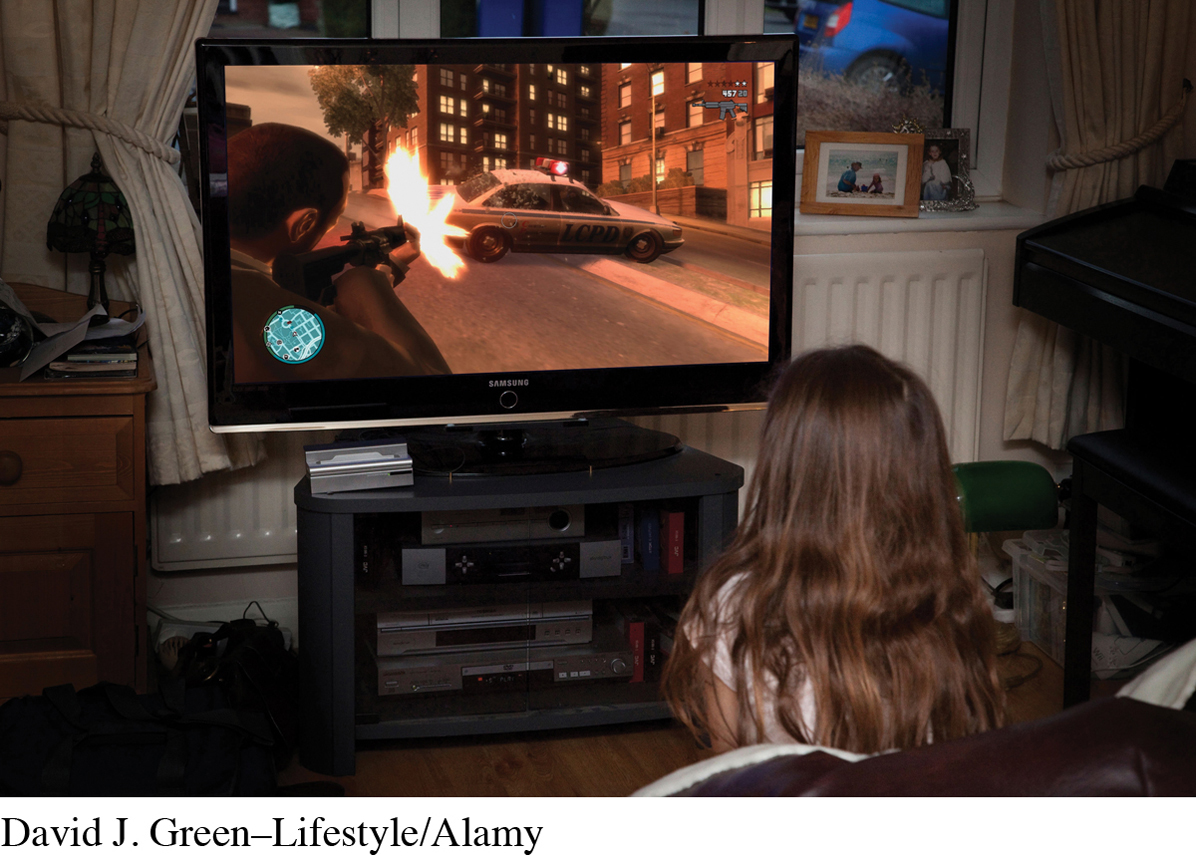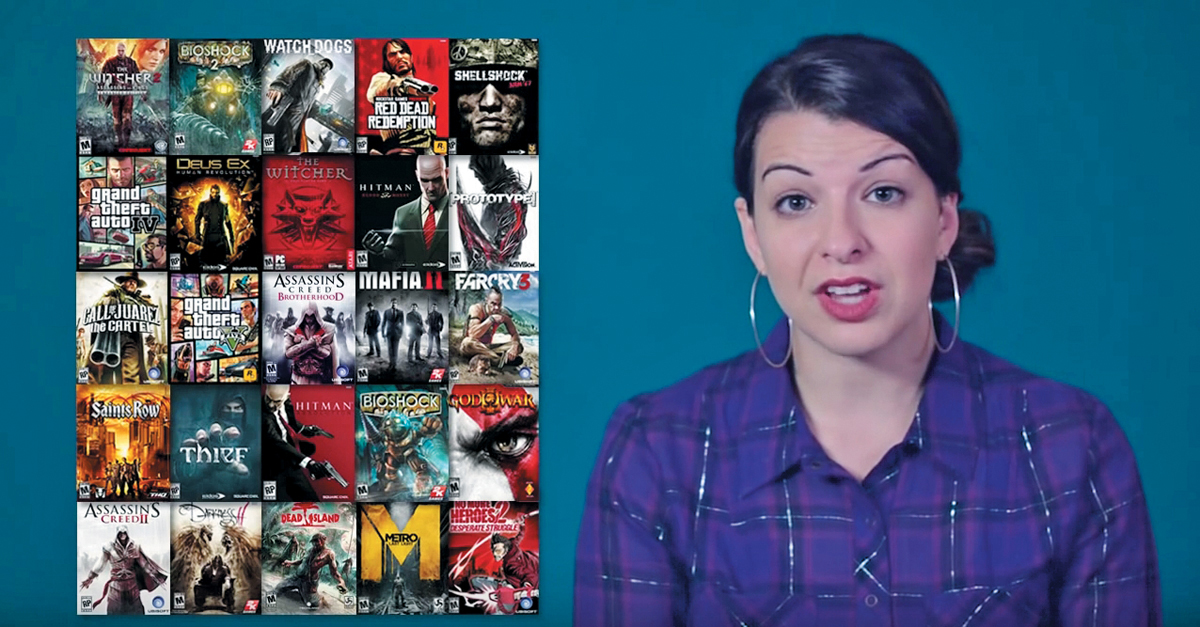Trends and Issues in Digital Gaming
The ever-
Electronic Gaming and Media Culture
Beyond the immediate industry, electronic games have had a pronounced effect on media culture. For example, fantasy league sports have spawned a number of draft specials on ESPN as well as a regular podcast, Fantasy Focus, on ESPN Radio. Fantasy football has even inspired an adult comedy called The League on the cable channel FXX. In the case of the Web site Twitch, streaming and archived video of digital games being played is the content. In just three years, the site became so popular that Amazon bought it for almost $1 billion to add to its collection of original video programming.
Like television shows, books, and comics before them, electronic games have inspired movies, such as Lara Croft: Tomb Raider (2001), the Resident Evil series (2001–present, including a sixth installment due in 2016), and Need for Speed (2014). Tron (1982), a movie inspired by video games, spurred an entire franchise of books, comic books, and arcade and console video games in the 1980s; and it was revived a generation later with an Xbox LIVE game in 2008, a movie sequel (Tron: Legacy) in 2010, and a Disney television series. For many Hollywood blockbusters today, a video game spin-
Books and electronic games have also had a long history of influencing each other. Japanese manga and anime (comic books and animation) have also inspired video games, such as Akira, Astro Boy, and Naruto. Batman: Arkham Asylum, a top video game title introduced in 2009, is based closely on the Batman comic-

HIGH-
Electronic Gaming and Advertising
Commercialism is as prevalent in video games as it is in most entertainment media. Advergames, like television’s infomercials or newspapers and magazines’ advertorials, are video games created for purely promotional purposes. The first notable advergame debuted in 1992, when Chester Cheetah, the official mascot for Cheetos snacks, starred in two video games for the Sega Genesis and Super Nintendo systems—
Some in-
Google’s game advertising strategy, launched in 2008, is to place increasing numbers of ads in well-
Addiction and Other Concerns
Though many people view gaming as a simple leisure activity, the electronic gaming industry has sparked controversy. Parents, politicians, the medical establishment, and media scholars have expressed concern about the addictive quality of video games, especially MMORPGs, and have raised the alarm about violent and misogynistic game content—
Addiction
No serious—
Gender is a factor in game addiction: A 2013 study found that males are much more susceptible to game addiction. This makes sense, given that the most popular games—
This is especially true of multiplayer online games—
This strategy of promoting habit formation may not differ from the cultivation of other media obsessions, like watching televised sporting events. Even so, real-
Meanwhile, industry executives and others cite the positive impact of digital games, such as the mental stimulation and educational benefits of games like SimCity, the health benefits of Wii Fit, and the socially rewarding benefits of playing games together as a family or with friends.
Violence and Misogyny
The Entertainment Software Association (ESA)—the main trade association of the gaming industry—
Most games involving combat, guns, and other weapons are intentionally violent, with representations of violence becoming all the more graphic as game visuals reach cinematic hyperrealism. The most violent video games, rated M for “Mature,” often belong to the first-
That some games can be violent and misogynistic is not a point of dispute. But the possible effects of such games have been debated for years, and video games have been accused of being a factor in violent episodes, such as the Columbine High School shootings in 1999. Earlier research linked playing violent video games to aggressive thoughts or hostility, but those effects don’t necessarily transfer to real-
There is less research on misogyny (hatred of women) in video games. One of the most extreme game narratives is from Grand Theft Auto 3, in which male characters can pick up female prostitutes, pay money for sex, get an increase in player “health,” and then beat up or kill the hooker to get their money back. Although women are close to half of the digital game audience in the United States, it’s likely that many aren’t engaged by this story. The source of the problem may be the male insularity of the game development industry—

GAMES IN THE GRAND THEFT AUTO series typically receive a rating of “Mature,” indicating they should not be sold to players under seventeen. However, the ratings do not distinguish between overall game violence and misogynistic attitudes.
GLOBAL VILLAGE
Global Controversy: The Gender Problem in Digital Games
A nita Sarkeesian has a well-
“The games often reinforce a similar message, overwhelmingly casting men as heroes and relegating women to the roles of damsels, victims or hypersexualized playthings,” Sarkeesian said. “The notion that gaming was not for women rippled out into society, until we heard it not just from the games industry, but from our families, teachers and friends. As a consequence, I, like many women, had a complicated, love–hate relationship with gaming culture.”1
“Love–hate” is probably also a good way to describe the reaction to Sarkeesian’s critique of games. On the one hand, she has gained critical acclaim and visibility for her videos and writing, appearing in the New York Times, Businessweek, and Rolling Stone, as well as on The Colbert Report. On the other hand, since she began releasing her videos on digital games, she has been the target of a global campaign of incredibly graphic and violent threats of rape, torture, and murder on social media. This ongoing online harassment reached a new low in the fall of 2014, when another of her Feminist Frequency video releases coincided with what has become known as the #GamerGate controversy.
The story surrounding the event that ostensibly touched off the #GamerGate firestorm began when a computer programmer, Eron Gjoni, had a bad breakup with game designer Zoe Quinn. Gjoni then went online with their breakup in a 9,425-

It was at this point that Sarkeesian (and other critics) spoke up and pointed out that the deeply disturbing threats that female gamers and critics were experiencing proved her point about a deeper problem in the gaming culture, which in turn reflected broader cultural misogyny. In response to this criticism, many supporters of #GamerGate started behaving even worse.
Soon Sarkeesian and others weren’t just receiving anonymous and graphic threats in places like Twitter, disturbing enough on its own, but found themselves victims of doxing and swatting. To “dox” someone means to steal private or personal information (from addresses and personal phone numbers to social security and credit card information in some cases) and make it public. To “swat” someone means to call in an anonymous tip to a police department where a victim lives in an attempt to provoke a raid—
In another case, before a scheduled speech by Sarkeesian at Utah State University, an anonymous person threatened to carry out the biggest school shooting ever if the video game critic spoke. Sarkeesian canceled her speech after campus police said Utah’s gun laws prohibited them from turning away any audience member who showed up with a gun. Sarkeesian went into hiding for a time, afraid to return to her home because of the various threats. Her Wikipedia page has been vandalized several times with pornographic pictures, and her Feminist Frequency Web site has been the target of Denial of Service attacks.
But Sarkeesian is far from giving up. In an ironic twist, the hatred leveled at the critic has brought many supporters her way as well. For example, in the first quarter of 2014, her crowdfunded Feminist Frequency Web site received $1,500 in donations. In the last quarter of 2014 (after #GamerGate really started heating up), donors sent almost $400,000 to Feminist Frequency (which is now officially a nonprofit organization dedicated to providing commercial-
Moreover, because the gaming news media was largely ignoring the misogyny of #GamerGate, Sarkeesian, Wu, and others began to speak out to mainstream news organizations, and coverage spread to Canada, the United Kingdom, Sweden, and elsewhere. With the #GamerGate controversy subject to greater international media scrutiny, the discussion began to change. “We finally shamed [the gaming news media] into finally addressing #GamerGate,” Wu said in a university speech. After being subjected to more than fifty death threats and constant bullying, and still feeling “damaged from this experience,” Wu perseveres. “We are making this better. We took #GamerGate and we turned it around in its tracks.”6
Media Literacy and the Critical Process
First-
Historical first-
1 DESCRIPTION. Red Dead Redemption features John Madsen, a white outlaw turned federal agent, who journeys to the “uncivilized” West to capture or kill his old gang members. Within this game, gamers encounter breathtaking vistas and ghost towns with saloons, prostitutes, and gunslingers; large herds of cattle; and scenes of the Mexican Rebellion. Shootouts are common in towns and on the plains, and gamers earn points for killing animals and people. The New York Times review notes that “Red Dead Redemption is perhaps most distinguished by the brilliant voice acting and pungent, pitch-
2 ANALYSIS. RDR may have “pitch-
3 INTERPRETATION. RDR may give us a technologically rich immersion into the Wild West of 1911, but it relies on clichés to do so (macho white gunslinger as leading man, weak or contemptible women, vigilante justice). If the macho/misogynistic narrative possibilities and value system of RDR seem familiar, it’s because the game is based on Rockstar’s other video game hit, Grand Theft Auto (GTA), which lets players have sex with and then graphically kill hookers. GTA was heavily criticized for creating an “X-
4 EVALUATION. The problem with Red Dead Redemption is its limited view of history, lack of imagination, and reliance on misogyny as entertainment. Since its gameplay is so similar to that of GTA, the specifics of time and place are beside the point—
5 ENGAGEMENT. Talk to friends about games like GTA, RDR, and Rockstar’s latest, L.A. Noire. (Set in 1940s Los Angeles, it also contains scenes with nudity and graphic violence against women.) Comment on blog sites about the ways some games can provide a mask for misogyny, and write to Rockstar itself (www.rockstargames.com), demanding less demeaning narratives regarding women and ethnic minorities.
Regulating Gaming
For decades, concern about violence in video games has led to calls for regulation. Back in 1976, an arcade game called Death Race prompted the first public outcry over the violence of electronic gaming. The primitive graphics of the game depicted a blocky car running down stick-
In 1993, after the violence of Mortal Kombat and Night Trap attracted the attention of religious and educational organizations, Senator Joe Lieberman conducted a hearing that proposed federal regulation of the gaming industry. Following a pattern established in the movie and music industries, the gaming industry implemented a self-
In the most recent effort to regulate video games, California passed a law in 2005 to fine stores $1,000 for selling video games rated M or AO to minors. In 2011, the U.S. Supreme Court struck down the law in a 7–2 decision, setting a difficult precedent for the establishment of other laws regulating electronic games.
The Future of Gaming and Interactive Environments
Gaming technology of the future promises a more immersive and portable experience that will touch even more aspects of our lives. The Wii has been successful in harnessing more interactive technology to attract nongamers with its motion-
Video games in the future will also continue to move beyond just entertainment. The term gamification describes how interactive game experiences are being embedded to bring competition and rewards to everyday activities.31 Games are already used in workforce training, for social causes, in classrooms, and as part of multimedia journalism. For example, to accompany a news report about texting while driving, the New York Times developed an interactive game, Gauging Your Distraction, to demonstrate the consequences of distractions (such as cell phones) on driving ability. All these developments continue to make games a larger part of our media experiences.
